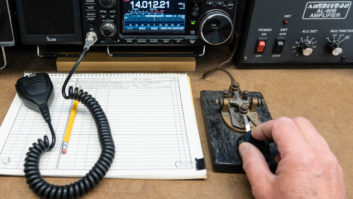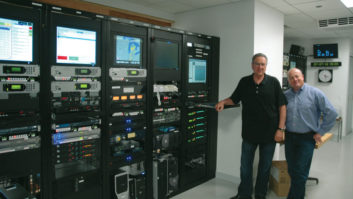
CHICAGO — For most of its nine decades of broadcasting, Chicago’s WGN Radio has been closely associated with one address: the famed Tribune Tower that anchors the southern end of Michigan Avenue’s Magnificent Mile.
While the station moved away in 1961 to a new joint radio-TV facility a few miles away near Wrigley Field, the radio side of WGN returned to Tribune Tower in 1986, occupying a spacious suite of offices and studios on the south side of the building’s ground floor that included a prominent “showcase studio” fronting on Michigan Avenue.
The Timetable
As those studios hit the quarter-century mark, WGN radio management began thinking about a move, even drawing up plans for a return to WGN’s TV building.
But the push for a move went into high gear in late 2011, when parent company Tribune Co. decided to lease WGN’s prime ground-floor space facing Pioneer Court to a restaurant — and it needed the space quickly.
That meant a busy year for WGN’s chief engineer, Jim Carollo, a veteran of 42 years. He’d been settling into a peaceful semi-retirement when the general manager at the time, Tom Langmyer, called him back to full-time duty to relocate WGN from the very studios Carollo had designed and built back in 1986, a facility Langmyer recalls as “the envy of all American radio” when it opened.
“I said, ‘Hey, you know what, wouldn’t it be great to have your legacy be this new thing instead of just the end of the old one,’” Langmyer recalls of the phone call when he summoned the 67-year-old Carollo.
“I think my sales skills worked.”
Carollo continued to work a part-time schedule in November and December of 2011 as he sketched out initial plans for the move. At the end of 2011, Tribune management signed off on the relocation, giving Carollo and his team just six months to clear out of their ground-floor digs.
“The nice thing about working for WGN is that you get to do the project the way you think it should be done, which you don’t get to do everywhere,” Carollo says. He prepared a budget for the move, which Tribune accepted without change, and the whirlwind project was underway.
“I had a lot to do in a short time,” Carollo recalls. “By the time we got to April, it became pretty much a full-time thing. I was working from six in the morning until six at night, but we got it done.”
Much of WGN’s new space on the seventh floor had been occupied by offices for the McCormick Foundation, the charitable legacy of the long-time Tribune publisher, Col. Robert McCormick. The foundation moved out after McCormick’s heirs sold the company, freeing the space for the radio station, which shares the seventh floor with CNN’s Chicago bureau offices and the Campbell Hall meeting room, which was, fittingly, one of the original TV studio spaces.
Divided into three “pods,” WGN’s new home spans both the original Tribune Tower and an addition that was built in the 1950s for TV. An area on the north side of the TV addition now provides office space for WGN Radio’s top management and its programming staff, as well as three production studios. Down a corridor on the east side of the building, WGN’s new sales and conference area enjoys a scenic view out to Lake Michigan a few blocks away.
Most of WGN’s broadcast operations are housed in the third part of the facility, in the original Tribune Tower building facing westward out to the bustle of Michigan Ave.

Langmyer says the windows on the seventh floor make a big difference to a staff that had been deep inside the ground floor studios.
“The studios and guts of the station were all inside the building, so you could be doing all these shows and people would have no visibility inside,” he recalls.
The new studio area includes a pair of air studios arrayed along a corridor across from a new rack room and a traffic studio. On the other side of the studio core, WGN’s new newsroom also enjoys the Michigan Ave. view as well as sightlines into a sports office/studio and an office/studio area for WGN’s iconic agricultural director, Orion Samuelson.
The System
“The audio system is mainly Wheatstone,” Carollo said, in part because that’s what is in place on the TV side. “Rather than reinvent the wheel, we wanted to be compatible with what they know there.”
For a station that’s heavily dependent on telephone talk, the choice of a phone system was a critical decision. “We had to replace the custom phone system we built in 1995. It came from Gentner, which of course is no longer in business. It was a purely analog system, which in today’s world no longer flies.”
In its place, WGN picked the Telos VX system. “It’s expandable, it’s digital and for the future it’s going to be what we need.”
Amidst the new consoles and phone system, Carollo decided to move one piece of the old facility essentially unchanged, sticking with the existing version of BE AudioVault that was running in the downstairs studio.
“We felt it would be too much of a shock to the engineering department and to the station to put in a new automation system, even just to move up to the current version of AudioVault,” Carollo says. “We had enough redundancy in the system, with multiple servers in multiple rooms, that we could move the backup server to the seventh floor while we stayed in operation from the main server downstairs.”
When you’re moving a big-market station, the quirks of the air talent come into play, too, which is why a pile of older MiniDisc recorders made the trip upstairs.
“Some of the talent still like to use MiniDiscs,” Carollo says, “but everywhere there’s MiniDisc, there’s also a new flash drive recorder, so we’re getting them moved over.”
The different needs of different talent are reflected in the new studios’ layouts as well. The large “Studio A” at the end of the corridor is designed for combo operation and the large cast of WGN’s Garry Meier morning show.
“About 85–90 percent of our programs run combo,” Carollo says, “but for other shows, especially ‘Extension 720’ [WGN’s evening talk show], we need a separate operator, so we had to have a studio that was designed to do that.” WGN also holds the play-by-play rights for Cubs baseball, Blackhawks hockey and Northwestern University sports, which all require board operators but not necessarily studio hosts.
“So that second studio, Studio B, we divided into a dual-function studio so it can be a combo studio or an operator studio.”
When there are multiple sports teams playing at once, the production studios on the administration side of the building can also be brought into play, providing still more options to meet WGN’s programming needs.
Adding the rebuilt Showcase Studio to the mix — it’s in use most days from 9 a.m. until 11 p.m. unless WGN is running sports — gives Carollo and his engineering team plenty of flexibility for maintenance and emergency repairs.
Because the new studio layout did not allow for sightlines between the newsroom and the air studios, or between the traffic studio and the air studios, Carollo turned to high-definition video to link the rooms and provide continuity on the air.
“On the first floor, we had simple security-type cameras in every room so you could see the host, and just a 20-by-20 video router,” Carollo says. But the team wanted something more elaborate for webcasts and simulcast with the TV operation, so it put in HD cameras on the LAN. His colleagues on the TV side helped design that.
The new video system puts a split screen on the 24-inch monitors in each studio, allowing hosts and producers to easily see who’s ready to go on the air, including the TV weather forecasters who deliver their reports from the TV studios several miles away.
As the clock ticked down to the July 1 deadline to be out of the ground-floor space on the south side of Tribune Tower, Carollo was working right up to the deadline to get everything ready upstairs.
“I turned it on June 30 at 10 p.m., two hours before that day ended,” Carollo says. “I made July 1 by two hours.”
Once the new studios went on the air on the seventh floor, Carollo had to move very quickly to salvage anything that was still needed from the old studios. Some peripheral equipment, including CD players and those MiniDisc recorders, was moved upstairs to the new studios. The contents of WGN’s large main talk studio, where icons such as Bob Collins had worked, was preserved intact as a donation to the nearby Museum of Broadcast Communications, where it will eventually be reassembled for display.
“We had about five days to move what we really needed into a part of the ground floor that wasn’t being demolished,” Carollo recalls. “The strangest thing was to walk into the space that had been a radio station just a week ago, and there was almost no trace that it had ever been a radio station.”
Once the initial rush of the move was over, Carollo still had to oversee the reconstruction of the Showcase Studio, the last piece of the facility to be updated.
“It took about two months to fine-tune everything,” Carollo says. On August 24, he celebrated his last day as a full-time WGN employee, but he still spends a day a week at Tribune Tower to make sure everything’s functioning smoothly.
Langmyer says the result reflects the importance Tribune places on its lone remaining radio property. Without disclosing specific numbers, Langmyer says WGN spent north of a million dollars for the studios alone,” in addition to the cost of the office relocation.
“I think this investment really speaks to the viability of WGN Radio,” he says. “We’re very bullish about the future of content.”











